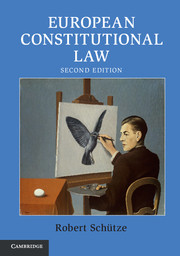Book contents
- Frontmatter
- Dedication
- Summary Contents
- Contents
- List of Illustrations
- List of Tables
- List of Cases
- List of Secondary Law
- Table of Equivalents
- List of Abbreviations
- Acknowledgements
- Introduction: European Constitutional Law
- Part I Constitutional Foundations
- 1 Constitutional History: From Paris to Lisbon
- 2 Constitutional Nature: A Federation of States
- 3 European Law I: Nature – Direct Effect
- 4 European Law II: Nature – Supremacy/Pre-emption
- 5 Governmental Structure: Union Institutions I
- 6 Governmental Structure: Union Institutions II
- Part II Governmental Powers
- Appendices
- Index
- References
1 - Constitutional History: From Paris to Lisbon
from Part I - Constitutional Foundations
- Frontmatter
- Dedication
- Summary Contents
- Contents
- List of Illustrations
- List of Tables
- List of Cases
- List of Secondary Law
- Table of Equivalents
- List of Abbreviations
- Acknowledgements
- Introduction: European Constitutional Law
- Part I Constitutional Foundations
- 1 Constitutional History: From Paris to Lisbon
- 2 Constitutional Nature: A Federation of States
- 3 European Law I: Nature – Direct Effect
- 4 European Law II: Nature – Supremacy/Pre-emption
- 5 Governmental Structure: Union Institutions I
- 6 Governmental Structure: Union Institutions II
- Part II Governmental Powers
- Appendices
- Index
- References
Summary
Introduction
The idea of European unification is as old as the European idea of the sovereign State. Yet the spectacular rise of the latter overshadowed the idea of European union for centuries. Within the twentieth century, two ruinous world wars and the social forces of globalisation have increasingly discredited the idea of the sovereign State. The decline of the monadic State found expression in the spread of inter-state cooperation. And the rise of international cooperation caused a fundamental transformation in the substance and structure of international law. The changed reality of international relations necessitated a change in the theory of international law.
The various efforts at European cooperation after the Second World War formed part of this general transition from an international law of coexistence to an international law of cooperation. ‘Europe was beginning to get organised.’ This development began with three international organisations. First: the Organisation for European Economic Cooperation (1948), which had been created after the Second World War by 16 European States to administer the international aid offered by the United States for European reconstruction. Secondly, the Western European Union (1948, 1954) that established a security alliance to prevent another war in Europe. Thirdly, the Council of Europe (1949), which had inter alia been founded to protect human rights and fundamental freedoms in Europe. None of these grand international organisations was to lead to the European Union. The birth of the latter was to take place in a much humbler sector.
The 1951 Treaty of Paris set up the European Coal and Steel Community (ECSC). Its original members were six European States: Belgium, France, Germany, Italy, Luxembourg and the Netherlands. The Community had been created to integrate one industrial sector; and the very concept of integration indicated the wish of the contracting States ‘to break with the ordinary forms of international treaties and organisations’.
The Treaty of Paris led to the 1957 Treaties of Rome. The latter created two additional Communities: the European Atomic Energy Community and the European (Economic) Community. The ‘three Communities’ were partly ‘merged’ in 1967, but continued to exist in relative independence. A major organisational leap was taken in 1993, when the Maastricht Treaty integrated the three Communities into the European Union. But for a decade, the Treaty on European Union was under constant constitutional construction.
- Type
- Chapter
- Information
- European Constitutional Law , pp. 3 - 42Publisher: Cambridge University PressPrint publication year: 2015

